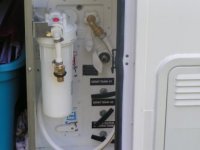We are full-timers. Have a 3670 38' 2010 Big Horn. We love our 5th wheel.
We are from Oregon and have never had to worry about having good water.
But, being in southwest, Arizona mostly, good water is not always available.
We have talked to many people and there is as many water filter sysems. It is very confusing.
We are have a couple of water filters on the outside of our 5th wheel.
But I'm thinking maybe we should have another filter inside.
We have had some recommend the Berkey Filter.
Any comments on the Berkey Filter.
I value everyone's opinion on this web-site. help. cheri
We are from Oregon and have never had to worry about having good water.
But, being in southwest, Arizona mostly, good water is not always available.
We have talked to many people and there is as many water filter sysems. It is very confusing.
We are have a couple of water filters on the outside of our 5th wheel.
But I'm thinking maybe we should have another filter inside.
We have had some recommend the Berkey Filter.
Any comments on the Berkey Filter.
I value everyone's opinion on this web-site. help. cheri

